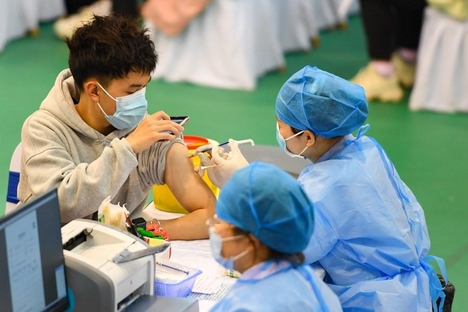Input 2021.04.06 17:14 | Revision 2021.04.06 17:35
The Chinese government has launched a nationwide campaign to increase corona vaccinations. This is because of the sense of crisis that the vaccination rate is significantly lower than that of other countries. In particular, the US became impatient as it was predicted that 75% of the population would be vaccinated in three months to achieve collective immunity. Some local governments induce vaccinations by presenting cash and shopping coupons. Currently, vaccination in China is a voluntary vaccination according to individual choice. However, as some local governments, companies, and schools have pressed vaccinations, criticism of the coercive method is also emerging.

On the 22nd of last month, the Chinese government set a goal that by the end of June, about 40% of the population, 560 million people (for 1.12 billion doses), will be vaccinated against the coronavirus. The Chinese government’s plan is to increase the vaccination rate to 64% by achieving the first goal before July, which marks the 100th anniversary of the CCP, and then completing an additional 330 million vaccinations by the end of the year. Only then will I be able to safely hold the Beijing Winter Olympics, a large international event in February next year.
However, the current vaccination rate in China is only around 4%. China’s National Hygiene and Health Commission (NHC) announced on the 6th that the number of vaccinations in Korea was more than 142.8 million as of the 5th. This is more than 3 million times higher than the day before. NHC announced that it will increase the number of daily vaccinations to more than 10 million in the near future.

Some analysts say that China quickly controlled the spread of the coronavirus last year, so the current Chinese people do not feel the need or urgency to get a vaccine. In an online seminar on the 20th of last month, an expert on respiratory diseases, Zhongnanshan, a Chinese engineer, said, “Since the Chinese people think the corona is controlled, the number of people who want to get the vaccine is small.” At the same time, Yuan warned, “If China fails to increase the vaccination rate, it will fall behind normalization compared to other countries.” In recognition of her contribution to the prevention of coronavirus, Jung Won received the Republic’s Medal from Chinese President Xi Jinping in September of last year.

Propaganda activities mobilized by state media are also active. If you don’t get the vaccine, you’re inciting yourself to be a selfish person. An anchor from the state broadcaster CCTV said, “Vaccination is not just an individual choice, it is the responsibility and duty of all Chinese people.”
State media are also encouraging them to get ahead of the United States by joining the vaccinations. According to the US Centers for Disease Control and Prevention (CDC), 16.2 million people, 32.0% of the population, were vaccinated at least once on 4 days. 18.5% (61.4 million people) of the population who completed the vaccination (in the case of two doses, both were vaccinated) also reached. On the 5th, Bloomberg said that 75% of the population could be vaccinated after 3 months if an average of 3 million doses per day in the United States were continued. This is the level at which collective immunity is formed.
